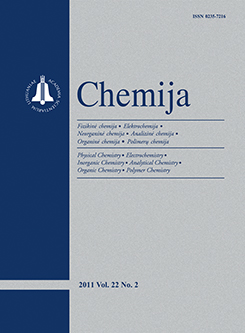Chemija / Chemistry
 ISSN 0235-7216 ISSN 2424-4538 (online) |
2015 m. Nr. 3 When chemistry meets biology: the case of aluminium – a review
Aluminium chemistry is extraordinary and complex because of a large spectrum of inorganic and organometallic complexes of varying stability in solutions. Being reactive, aluminium has the potential to interact with and influence many biomolecules, biochemical pathways, cellular processes and physiological functions, thus causing high Al toxicity. It depends not only on the total Al concentration but also on the abundance of Al chemical forms, Al speciation being highly dependent on the pH and chemical environment of the solution. The oxidative potential of aluminium leads to enhanced oxidative stress, which explains part of Al toxicity mechanisms. Al is a known pro-oxidative, cytotoxic, neurotoxic, immunogenic, pro-inflammatory and mutagenic agent. Usually, organisms are not exposed to relevant levels of aluminium but long-term accumulation causes several human diseases and disturbs plant growth. In contrast to animals and humans, plants evolved specific mechanisms to cope with Al stress. We review the existing knowledge about aluminium chemical properties, bioavailability and cell responses determining Al toxicity not only in humans but also in plants. Extraordinary chemistry of Al and complexity of biological processes require complex researches to link knowledge of Al chemistry and biology of its effects in order to find the best solution to resist the aluminium toxicity.
Keywords: aluminium, aluminium bioavailability, aluminium toxicity, aluminium related diseases, plant resistance to aluminium |
Issues:
2017 - Vol.28 No. 1, No. 2, No. 3, No. 4 2016 - Vol.27 No. 1, No. 2, No. 3, No. 4 2015 - Vol.26 No. 1, No. 2, No. 3, No. 4 2014 - Vol.25 No. 1, No. 2, No. 3, No. 4 2013 - Vol.24 No. 1, No. 2, No. 3, No. 4 2012 - Vol.23 No. 1, No. 2, No. 3, No. 4 2011 - Vol.22 No. 1, No. 2, No. 3, No. 4 2010 - Vol.21 No. 1, No. 2-4 2009 - Vol.20 No. 1, No. 2, No. 3, No. 4 2008 - Vol.19 No. 1, No. 2, No. 3-4 2007 - Vol.18 No. 1, No. 2, No. 3, No. 4 2006 - Vol.17 No. 1, No. 2-3, No. 4 2005 - Vol.16 No. 1, No. 2, No. 3-4 2004 - Vol.15 No. 1, No. 2, No. 3, No. 4 2003 - Vol.14 No. 1, No. 2, No. 3, No. 4 2002 - Vol.13 No. 1, No. 2, No. 3, No. 4 2001 - Vol.12 No. 1, No. 2, No. 3, No. 4 |